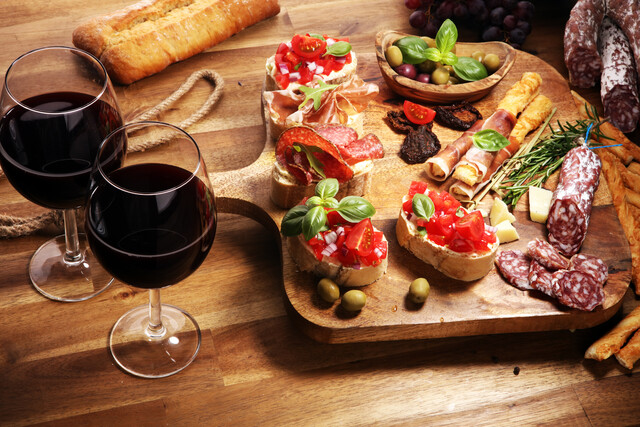Spanish Cuisine
Before we talk about the different cuisines and delicious dishes from the country, we should begin with a brief overview and history of the cuisine.
History of Spanish Food
Like many cultures of Hispanic origin, Spanish foods come from a long list of ancestry, and recipes are usually passed down in the family. Many of the cuisines were created to make use of simple ingredients that the everyday villager could afford or grow, and out of those options came a variety of dishes you still find on menus today. Though the concept of using leftover ingredients frequently throughout the week isn't a common practice for those living in the United States, many countries, especially those in Europe and Latin America, use leftover ingredients many times throughout the week. In an attempt to keep cuisines new, ingredients were transformed into various dishes.
If you were to travel around the United States, you would find the cuisines to be very different in each area of the country that you visited. The west and south have particular styles of cooking, ones you won't find in the Pacific Northwest or New England regions. The same goes for Spanish cuisine. Various regions in Spain have their own way of cooking or preparing food, so the paella you find in Madrid might not taste or look the same as the paella that you find in a countryside village.
Early in Spanish history, there were different influences of cooking in areas based on the inhabitants. For example, Jewish settlers influenced how stews were prepared in some regions, while the Moors influenced the creation of a well known dish known as gazpacho. Roman and Greek inhabitants brought varied flavors to the country, primarily in the form of wine and olive oil.
Traditional Dishes
Some of the most traditional ingredients in Spanish cooking are those you're likely familiar with, including chicken, lamb, and beef. Vegetables are a staple of Spanish cuisine, but as we mentioned before, the locations in which the vegetables are grown will determine their use in local dishes. When trade between the Americas began, Spanish food began to incorporate different ingredients into dishes, such as tomatoes, potatoes, and peppers.
Paella. Originating in Valencia, this dish is one of the most famous dishes to come out of the country, and no trip to Spain is complete without trying it. Depending on the location in which the dish is made, various ingredients are used. For example, inland regions typically use chicken or rabbit mixed with vegetables, while coastal regions used shellfish and other seafood. Many types of paella also feature a tasty sausage known as chorizo.
The paella is made with Spanish rice, vegetables, and a meat based on the location, then slow cooked until the rice is perfectly prepared. Paella is a hard dish to make, as it needs an ideal amount of liquid added to the rice to keep it from getting soggy or overcooked. This large, one-pot dish is traditionally eaten by a group of people.
Gazpacho. If you're visiting Spain in the summer months, a gazpacho soup is a must try. Originating from the Andalusia region of Spain, gazpacho is a cold soup derived from blended vegetables, such as cucumber, green pepper, onion, and tomatoes. Depending on the region in which you visit, the ingredients for gazpacho may vary; there are even fruit gazpachos, which are very refreshing on a hot day! The ingredients are very common in the regions throughout the country, and take very little time to prepare.
Migas. We talked about how leftovers were often used to create new dishes, and that is how Migas came about. In Spanish, Migas translates as breadcrumbs, and the dish was first created to use up leftover bread. Like many dishes, the region in which you order Migas will have an influence on how it is prepared, and what ingredients are used. The dish may be prepared either with a savory or a sweet influence, and contain various ingredients, such as bacon, chorizo, or paprika. Sweeter versions of Migas include fruit, such as melon or grapes, and in some cases, chocolate.
Sangria. One of the most famous drinks to come out of Spain is sangria, which dates back to the 15th century. The base ingredient for sangria is wine, and there are three variations from which to choose, using different wines, including a red wine and a white wine. Sangria mixes red wine with nectarines, peaches, and apricots. The most common recipe for sangria includes red wine, oranges, lemon, juice from both of these citrus fruits, peaches, and sugar. The tasty concoction is found in most restaurants, and if you've never tried it, the best place to do so is in Spain itself.
Eating Customs
One thing you may find interesting in Spain is that many of the bars and restaurants are one and the same. Food and socializing is very important for the culture, and residents use such locations as a meeting place after work, or as a social spot to hang out with friends.
Lunch is the most important meal of the day. When dining at a restaurant, you'll find there are several courses involved with the meal. After lunch, many shops and businesses will close between 2:00 and 4:00 in the afternoon to observe the naptime, commonly referred to as a siesta, so don't make any plans to do much of anything within that timeframe. Dinner is also served much later in Spain, often sitting down to the last meal of the day around 9:00 or 10:00 in the evening!
Conclusion
These are just a few of the well known dishes from Spain. When you visit, try as many dishes as possible to get a taste of the flavors and ingredients found in each dish. One of the best ways to enjoy a trip abroad is to eat like a local.















